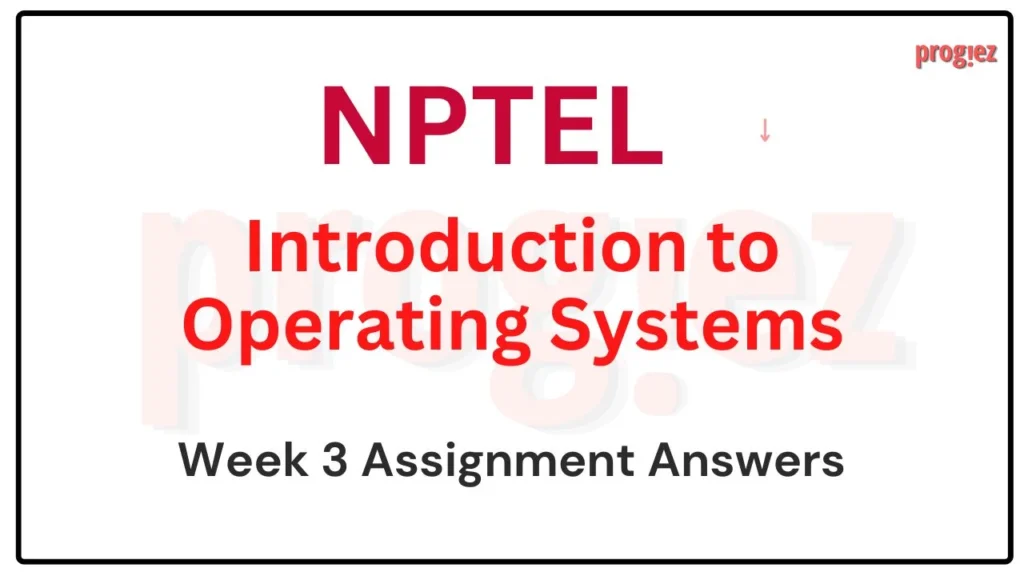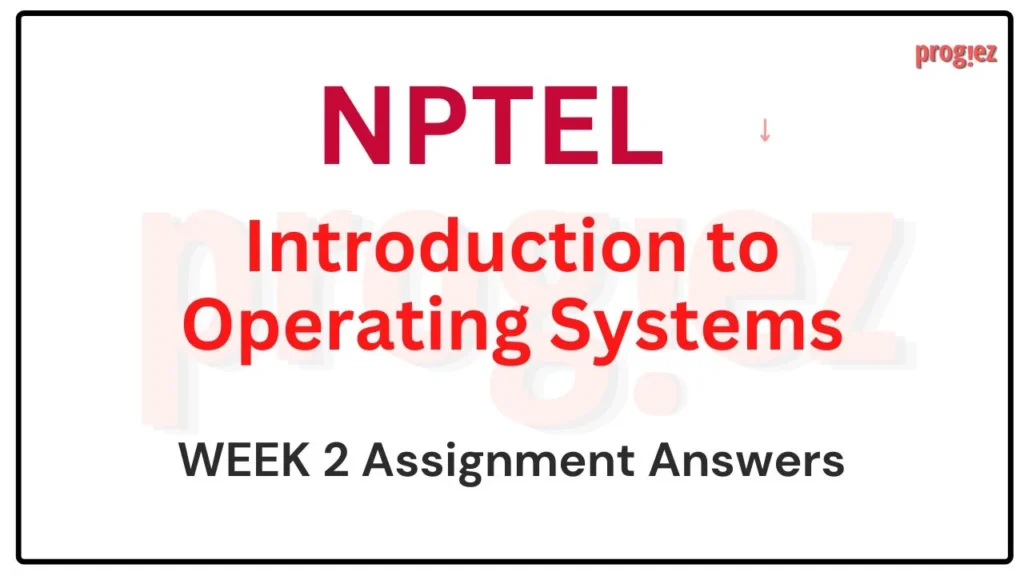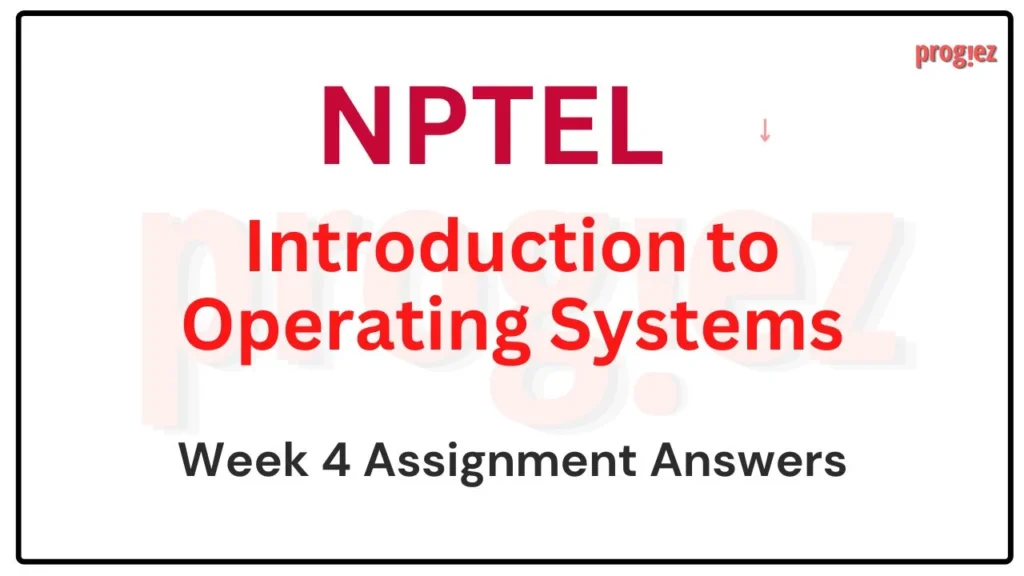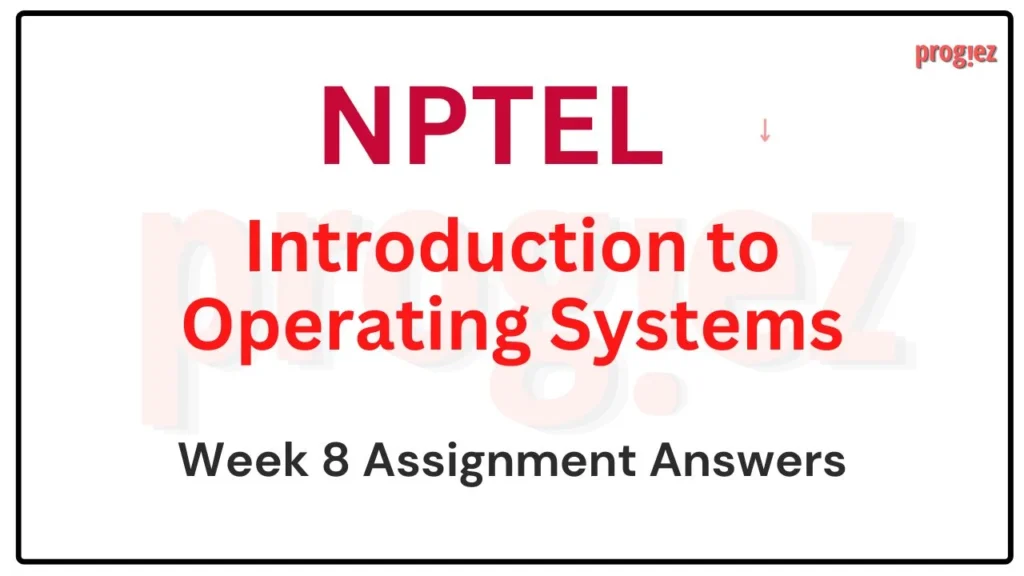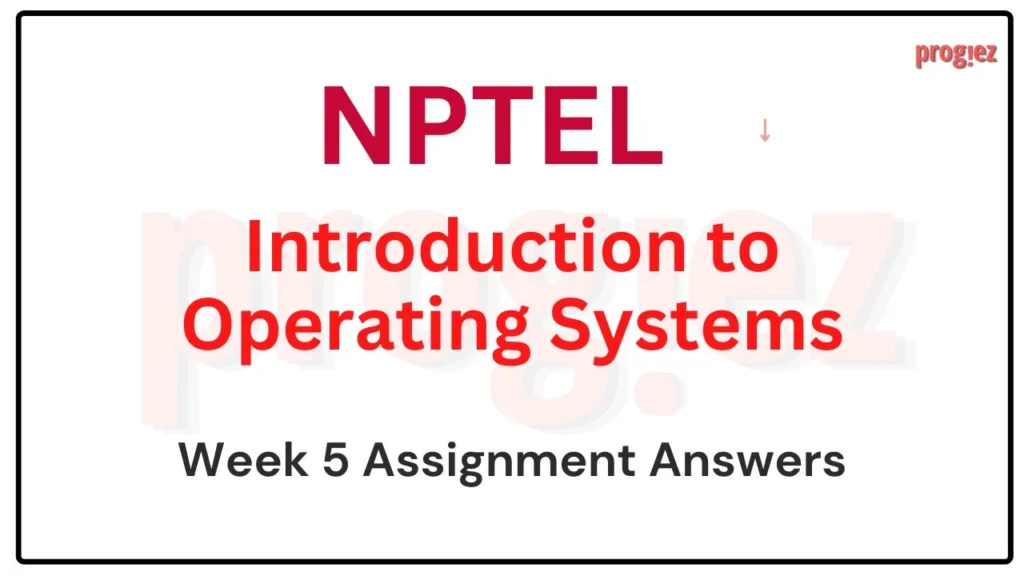Introduction to Operating Systems NPTEL Assignment 1
Session: JULY-DEC 2023
Course Name: Introduction to Operating Systems
Course Link: Click Here
These are Introduction to Operating Systems NPTEL Assignment 1 Answers
Q1. Which one of the following is false ?
Resource management needs to provide resource sharing.
Resource management should be transparent to applications.
Resource management hides the nitty gritty details of the program execution.
Resource management should improve the performance by efficient utilization.
Answer: Resource management hides the nitty gritty details of the program execution.
Q2. In the PC organization _ interfaces memory and PCI Bus
Front side Bus
South Bridge
Chipset
PCI-PCI Bridge
Answer: Chipset
Q3. State True or False?
Stack Pointer points to a frame present in the stack
True
False
Answer: False
These are Introduction to Operating Systems NPTEL Assignment 1 Answers
Q4. Which one of the following is the correct order of statements?
(1) Read byte by byte from memory
(2) Graphics card displays string on the monitor
(3) printf(“%s”,str)
(4) Device driver takes care of setting attributes.
3, 4, 1, 2
3, 1, 4, 2
1, 4, 2, 3
1, 2, 4, 3
Answer: 3, 1, 4, 2
Q5. Which one of the following is false ?
Monolithic Kernel has direct communication with all the modules.
Monolithic Kernel is faster than microkernel.
Microkernel is faster than monolithic kernels
Monolithic Kernel is more crashable compared to microkernel.
Answer: Microkernel is faster than monolithic kernels
Q6. State True or False?
Resource abstraction and hardware management are important uses of an OS.
True
False
Answer: True
These are Introduction to Operating Systems NPTEL Assignment 1 Answers
Q7. Which one of the following is false ?
Multiprogramming will not cause starvation.
Time sharing improves performance.
Scheduler should able to prioritize some applications.
Kernel runs in a protected mode.
Answer: Multiprogramming will not cause starvation.
Q8. Match the following
Instructions a. Heap section
Global and Static Data b. Stack section
Function call invocation c. Data section
Dynamic allocation d.Text section
1-b, 2-a, 3-d, 4-c
1-d, 2-c, 3-a, 4-b
1-c, 2-d, 3-b, 4-a
1-d, 2-c, 3-b, 4-a
Answer: 1-d, 2-c, 3-b, 4-a
Q9. Name the operating systems most suited for wireless sensor nodes.
Linux
Windows
Contiki OS
Mac OS
Answer: Contiki OS
These are Introduction to Operating Systems NPTEL Assignment 1 Answers
Q10. State True or False?
Access control and biometric are used to increase security of an operating system.
True
False
Answer: True
Q11. State True or False.
To extend the IO address range, we use the low memory region of the RAM as Memory mapped IO.
True
False
Answer: False
Q12. Match the following
a.out a. compiles the program
Process state b. Stored in hard disk
gcc hello.c c. executes from RAM
Process d. Hidden section of process maintained by OS
1-a, 2-b, 3-c, 4-d
1-b, 2-d, 3-a, 4-c
1-b, 2-a, 3-d, 4-c
1-a, 2-c, 3-d, 4-a
Answer: 1-b, 2-d, 3-a, 4-c
These are Introduction to Operating Systems NPTEL Assignment 1 Answers
Q13. State True or False?
printf() is a system call that switches from user space to kernel space.
True
False
Answer: False
Q14. MAX_SIZE in a 32 bit Linux Kernel is fixed at_____________.
Answer:
(Type: String) 0xc0000000
(Type: String) c0000000
Q15. Synchronization mechanism is used to avoid _.
Answer:
(Type: String) Race condition
(Type: String) Racecondition
(Type: String) Raceconditions
(Type: String) Race conditions
These are Introduction to Operating Systems NPTEL Assignment 1 Answers
More Weeks of Introduction to Operating Systems: Click here
More Nptel Courses: Click here
Introduction to Operating Systems Assignment
Course Link : https://nptel.ac.in/courses/106106144
Q1. A distributed system is a system whose components are located on different computers on a network, which communicate and coordinate their actions by passing messages to one another.
a. a and b
b. a and c
c. c and d
d. All of the above
Answers:- d. All of the above
Q2. Which one of the following is False ?
a. Monolithic Kernel has direct communication with all the modules.
b. Monolithic Kernel is faster than microkernel.
c. Microkernel is faster than monolithic kernels
d. Monolithic Kernel is more crashable compared to microkernel
Answers:- b. Monolithic Kernel is faster than microkernel.
These are Introduction to Operating Systems NPTEL Assignment 1 Answers
Q3. To extend the IO address range, we use the low memory region of the RAM as Memory mapped IO.
a. True
b. False
Answers:- b. False
Q4. Match the following?
a. 1-d, 2-c, 3-b, 4-a
b. 1-c, 2-d, 3-b, 4-a
C. 1-b, 2-a, 3-c, 4-d
d. 1-a, 2-b, 3-d, 4-a
Answers:- a. 1-d, 2-c, 3-b, 4-a
These are Introduction to Operating Systems NPTEL Assignment 1 Answers
Next Week Assignment Answers
Q5. fopen() system call switches from _____________ space
Answers:- USER
Q6. fopen() system call switches to _____________ space.
Answers:- KERNEL
Q7. For monolithic kernels, which of the following is False.
i) The entire kernel runs in protected mode.
ii) Communication between kernel modules is by system calls.
iii) Is likely to be more crashable.
a. I only
b. II only
C. I and III only
d. II and III only
Answers:- b. II only
These are Introduction to Operating Systems NPTEL Assignment 1 Answers
Q8. _____________ module in the operating system helps in communicating with hardware devices.
Answers:- DEVICE DRIVER
Q9. In the absence of system calls, a user process can never dynamically allocate memory.
a. True
b. False
Answers:- TRUE
Q10. What are the features of Contiki OS
a. Provide good user interface features
b. Energy aware scheduling.
C. Small footprint
d. Zigbee protocol support
These are Introduction to Operating Systems NPTEL Assignment 1 Answers
Answers:- b, c and d
Q11. With a monolithic kernel such as Linux, a process, when executing can occupy the entire 4GB address space (assuming a 32 bit system).
Answer:- True

